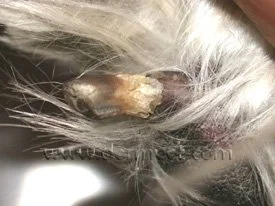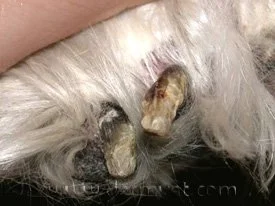Symmetrical Lupoid Onychodystrophy (SLO)
-
SLO is the most common immune-mediated disease that results in abnormal claws and eventual claw loss.
-
SLO has been described in dogs. German Shepherds appear predisposed. The highest incidence is found in young adult to middle-aged dogs.
-
There is usually an acute onset of nail loss. Initially, one or two claws are lost, but over the course of a few weeks to several months, all claws slough. Partial regrowth typically occurs, but claws are misshapen, soft or brittle, discolored, friable, and often slough again. The affected feet are often painful and/or itchy. Affected dogs are otherwise healthy. Occasionally, secondary bacterial nailbed infections occur.
-
See Clinical Signs.
-
Other diseases that need to be considered in the differentials include fungal and bacterial claw infections, autoimmune skin disorders, drug reactions, and vasculitis. In most instances a diagnosis can be made from visual inspection, however, a biopsy of the digit is required for definitive diagnosis.
-
The prognosis for nail regrowth is good, although some nails may remain deformed or friable. In some dogs, therapy can be discontinued after 6 months. In other cases, long-term maintenance therapy is needed to maintain remission. In cases refractory to medical therapy, P3 amputation can be considered.
-
Treat any secondary infections with appropriate antibiotics. SLO is commonly treated with daily oral fatty acids and oral Vitamin E. Noticeable nail regrowth should be noted within 3 months of initiating this therapy. Other treatments include Tetracycline Niacinamide, pentoxifylline, and for more severe refractory cases Prednisone and other nonsteroidal immunosuppressive drugs can be utilized. A food allergy has been identified in a few cases of this disease, so it may be appropriate to go through a strict, 8-12-week hypoallergenic food trial. A number of dogs have also been diagnosed with Hypothyroidism at the same time SLO has been diagnosed. A full thyroid panel may be indicated to evaluate this common hormonal disease.


